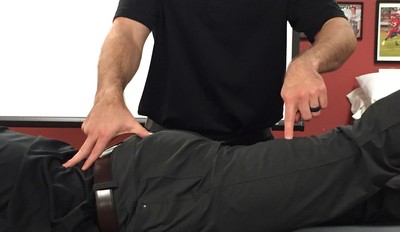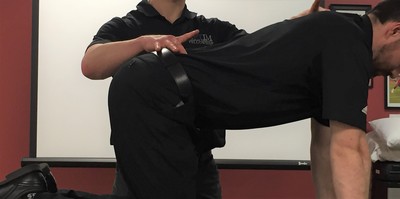- Home
- About Us
- TSPT Academy
- Online Courses
-
Resources
- Newsletter
- Business Minded Sports Physio Podcast
- Day in the Life of a Sports PT
- Residency Corner
-
Special Tests
>
-
Cervical Spine
>
- Alar Ligament Test
- Bakody's Sign
- Cervical Distraction Test
- Cervical Rotation Lateral Flexion Test
- Craniocervical Flexion Test (CCFT)
- Deep Neck Flexor Endurance Test
- Posterior-Anterior Segmental Mobility
- Segmental Mobility
- Sharp-Purser Test
- Spurling's Maneuver
- Transverse Ligament Test
- ULNT - Median
- ULNT - Radial
- ULNT - Ulnar
- Vertebral Artery Test
- Thoracic Spine >
-
Lumbar Spine/Sacroiliac Joint
>
- Active Sit-Up Test
- Alternate Gillet Test
- Crossed Straight Leg Raise Test
- Extensor Endurance Test
- FABER Test
- Fortin's Sign
- Gaenslen Test
- Gillet Test
- Gower's Sign
- Lumbar Quadrant Test
- POSH Test
- Posteroanterior Mobility
- Prone Knee Bend Test
- Prone Instability Test
- Resisted Abduction Test
- Sacral Clearing Test
- Seated Forward Flexion Test
- SIJ Compression/Distraction Test
- Slump Test
- Sphinx Test
- Spine Rotators & Multifidus Test
- Squish Test
- Standing Forward Flexion Test
- Straight Leg Raise Test
- Supine to Long Sit Test
-
Shoulder
>
- Active Compression Test
- Anterior Apprehension
- Biceps Load Test II
- Drop Arm Sign
- External Rotation Lag Sign
- Hawkins-Kennedy Impingement Sign
- Horizontal Adduction Test
- Internal Rotation Lag Sign
- Jobe Test
- Ludington's Test
- Neer Test
- Painful Arc Sign
- Pronated Load Test
- Resisted Supination External Rotation Test
- Speed's Test
- Posterior Apprehension
- Sulcus Sign
- Thoracic Outlet Tests >
- Yergason's Test
- Elbow >
- Wrist/Hand >
- Hip >
- Knee >
- Foot/Ankle >
-
Cervical Spine
>
- I want Financial Freedom
- I want Professional Growth
- I want Clinical Mastery
SI joint is an area that is often difficult to understand and treat. Here's a complimentary Insider Access video showing various advanced ways to treat the SIJ. |
|
FABER Test
Purpose: To assess for the sacroiliac joint or hip joint being the source of the patient's pain.
Test Position: Supine.
Performing the Test: The patient's tested leg is placed in a "figure-4" position, where the knee is flexed and the ankle is placed on the opposite knee. The hip is placed in flexion, abduction, and external rotation (which is where the name FABER comes from). The examiner applies a posteriorly directed force against the medial knee of the bent leg towards the table top. A positive test occurs when groin pain or buttock pain is produced. Due to forces going through the hip joint as well, the patient may experience pain if pathology is located in the hip as well.
Diagnostic Accuracy: Sensitivity: .71, Specificity: 1.0; -LR: .23 ("Pain provocation tests for the assessment of sacroiliac joint dysfunction"), +FABER Test in 97% of patients with labral impingement (phillippon et al, AJSM, 2007).
Importance of Test: When this test is clustered, it can prove highly useful in identifying those suffering from sacroiliac joint dysfunction. Check out the Lumbar Spine/Sacroiliac home page for the cluster. This tests the sacroiliac joint, because as the horizontal abduction force goes through the femur, the tensioned soft tissues transfer the forces to the sacroiliac joint. Hence, this test can indicate pathology located in the hip or sacroiliac joint. The test also assesses the hip, due to forces being transferred through the joint. The position of flexion, abduction, and external rotation, when combined with overpressure, stresses the femoral-acetabular joint and produces pain, if irritated.
Note: tests should only be performed by a properly trained health care practitioner.
Test Position: Supine.
Performing the Test: The patient's tested leg is placed in a "figure-4" position, where the knee is flexed and the ankle is placed on the opposite knee. The hip is placed in flexion, abduction, and external rotation (which is where the name FABER comes from). The examiner applies a posteriorly directed force against the medial knee of the bent leg towards the table top. A positive test occurs when groin pain or buttock pain is produced. Due to forces going through the hip joint as well, the patient may experience pain if pathology is located in the hip as well.
Diagnostic Accuracy: Sensitivity: .71, Specificity: 1.0; -LR: .23 ("Pain provocation tests for the assessment of sacroiliac joint dysfunction"), +FABER Test in 97% of patients with labral impingement (phillippon et al, AJSM, 2007).
Importance of Test: When this test is clustered, it can prove highly useful in identifying those suffering from sacroiliac joint dysfunction. Check out the Lumbar Spine/Sacroiliac home page for the cluster. This tests the sacroiliac joint, because as the horizontal abduction force goes through the femur, the tensioned soft tissues transfer the forces to the sacroiliac joint. Hence, this test can indicate pathology located in the hip or sacroiliac joint. The test also assesses the hip, due to forces being transferred through the joint. The position of flexion, abduction, and external rotation, when combined with overpressure, stresses the femoral-acetabular joint and produces pain, if irritated.
Note: tests should only be performed by a properly trained health care practitioner.
|
|
|
References:
Broadhurst N, Bond M. "Pain provocation tests for the assessment of sacroiliac joint dysfunction." J Spinal Disorders 1998; 11: 341-345.
Phillippon et al, AJSM, 2007.
Broadhurst N, Bond M. "Pain provocation tests for the assessment of sacroiliac joint dysfunction." J Spinal Disorders 1998; 11: 341-345.
Phillippon et al, AJSM, 2007.
Copyright © The Student Physical Therapist LLC 2023




